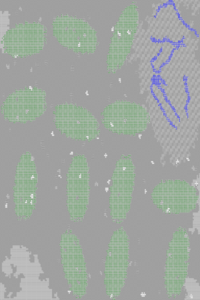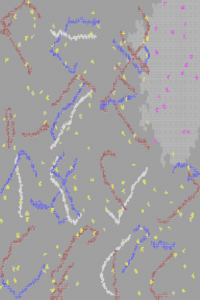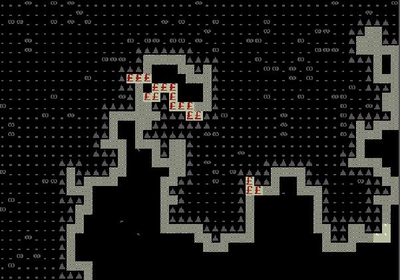- v50 information can now be added to pages in the main namespace. v0.47 information can still be found in the DF2014 namespace. See here for more details on the new versioning policy.
- Use this page to report any issues related to the migration.
Vein
| This article was migrated from DF2014:Vein and may be inaccurate for the current version of DF (v50.12). See this page for more information. |
v50.12 · v0.47.05 This article is about the current version of DF.Note that some content may still need to be updated. |
If a stone is not a layer stone, then it is found within a layer or another stone as a vein or a cluster. Veins and clusters do not jump z-levels, except by coincidence - a vein or cluster is limited to one z-level, but that doesn't mean the same stone can't be found above or below as well if the conditions (the surrounding stone) are right. However, multi-Z-level veins and clusters are planned for a future release.
Non-layer stone formations occur only in one of these four patterns:
- Large cluster - An oval that occupies nearly half of a 48x48 block, area-wise, and completely contained within the boundaries of that block, which tends to center them. These huge ovals consistently measure near 20 x 40 tiles, and average perhaps 750 stones each. Only one appears per block, and while veins and small clusters can be found in some few stone types, large clusters typically do not consist of useful or valuable stones (magnetite being a notable exception).
- Even if a block contains a large cluster, it will likely also contain numerous other independent veins or small clusters, even within the large cluster itself.
- Vein - A sinuous line of the material crosses part of the block. These vary from 1-4 tiles wide within a single vein and average about 100 stones each, but veins with over 200 stones have been reported*. When a vein ends, it does not start again unless it was broken by another vein, cluster or erosion (see below).
- (* It's ~possible~ that these are 2 identical veins lined up end-to-end, but it's unclear if there is an upper limit as to how big a single vein can be.)
- Small cluster - A sprinkle of 1 to 9 adjacent tiles. Multiple small clusters of different materials may be in the same block. These average 4-5 adjacent stones each and do not span more than three tiles in each direction. (That is, all tiles are enclosed in a 3x3 square area.)
- Single Gem - Rare gems show up only as a single example within a small cluster of similar precious gems; for example, a star ruby will only be found within a cluster of rubies, and a clear diamond will only appear in a cluster of faint yellow diamonds, etc. (Since "small clusters" occasionally have only 1 gem in them, it's theoretically possible that a rare gem could be found alone - this would, indeed, be rare.)
Two independent veins (of the same or different stone/ore) can sometimes be found "doubled", next to each other, or folded back on themselves. Unrelated veins and clusters can also intersect or overlap with each other - only one type of stone/ore/gem will be found in any one tile, however.
Note also that erosion (pre-embark, during world-gen), rivers and underground caverns may reduce exposed veins and clusters to a fraction of their original starting size, and/or cut through them, exposing only the remnants, or two parts of a single vein in two nearby areas on the same z-level.
It is common to find certain gemstones embedded only in certain veins or large clusters. For instance, to find rubies and sapphires, explore bauxite clusters; for diamonds, one should follow any kimberlite veins they find, which in turn are found only in gabbro layers. Knowing what stone (or ore) contains what veins and clusters can be useful in exploratory mining and to understand the information given to you before you embark on a new game, and complete information for each can be found on the wiki page for that stone/ore/gem.
Raw adamantine is neither a typical stone nor metal ore, and deposits of raw adamantine do not follow any of the normal patterns.
See also[edit]
- Stone
- Ore
- Gem
- Soil
- Exploratory mining
- (also, any individual types of stone, ore, or gem, by specific name - for instance, granite or native gold.)
- And, for newer players, The Non-Dwarf's Guide to Rock


